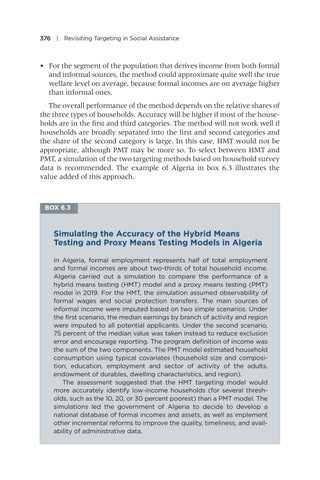376 | Revisiting Targeting in Social Assistance
• For the segment of the population that derives income from both formal and informal sources, the method could approximate quite well the true welfare level on average, because formal incomes are on average higher than informal ones. The overall performance of the method depends on the relative shares of the three types of households. Accuracy will be higher if most of the households are in the first and third categories. The method will not work well if households are broadly separated into the first and second categories and the share of the second category is large. In this case, HMT would not be appropriate, although PMT may be more so. To select between HMT and PMT, a simulation of the two targeting methods based on household survey data is recommended. The example of Algeria in box 6.3 illustrates the value added of this approach.
BOX 6.3
Simulating the Accuracy of the Hybrid Means Testing and Proxy Means Testing Models in Algeria In Algeria, formal employment represents half of total employment and formal incomes are about two-thirds of total household income. Algeria carried out a simulation to compare the performance of a hybrid means testing (HMT) model and a proxy means testing (PMT) model in 2019. For the HMT, the simulation assumed observability of formal wages and social protection transfers. The main sources of informal income were imputed based on two simple scenarios. Under the first scenario, the median earnings by branch of activity and region were imputed to all potential applicants. Under the second scenario, 75 percent of the median value was taken instead to reduce exclusion error and encourage reporting. The program definition of income was the sum of the two components. The PMT model estimated household consumption using typical covariates (household size and composition, education, employment and sector of activity of the adults, endowment of durables, dwelling characteristics, and region). The assessment suggested that the HMT targeting model would more accurately identify low-income households (for several thresholds, such as the 10, 20, or 30 percent poorest) than a PMT model. The simulations led the government of Algeria to decide to develop a national database of formal incomes and assets, as well as implement other incremental reforms to improve the quality, timeliness, and availability of administrative data.


